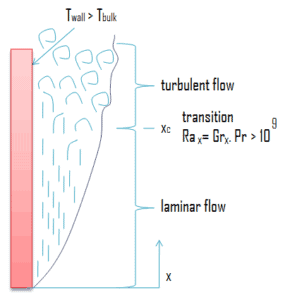Laminar and Turbulent Natural Convection
 It is important to note that natural convection boundary layers are not restricted to laminar flow. As with forced convection, hydrodynamic instabilities may arise. That is, disturbances in the flow may be amplified, leading to transition from laminar to turbulent flow. For a vertical flat plate, the flow turns turbulent for value of:
It is important to note that natural convection boundary layers are not restricted to laminar flow. As with forced convection, hydrodynamic instabilities may arise. That is, disturbances in the flow may be amplified, leading to transition from laminar to turbulent flow. For a vertical flat plate, the flow turns turbulent for value of:
Rax = Grx . Pr > 109
As in forced convection the microscopic nature of flow and convection correlations are distinctly different in the laminar and turbulent regions.
Natural Convection – Correlations
As was written, most heat transfer correlations in natural convection are based on experimental measurements and engineers often use proper characteristic numbers to describe natural convection heat transfer. The characteristic number that describes convective heat transfer (i.e. the heat transfer coefficient) is the Nusselt number, which is defined as the ratio of the thermal energy convected to the fluid to the thermal energy conducted within the fluid. The Nusselt number represents the enhancement of heat transfer through a fluid layer as a result of convection relative to conduction across the same fluid layer. But in case of free convection, heat transfer correlations (for the Nusselt number) are usually expressed in terms of the Rayleigh number.
The Rayleigh number is used to express heat transfer in natural convection. The magnitude of the Rayleigh number is a good indication as to whether the natural convection boundary layer is laminar or turbulent. The simple empirical correlations for the average Nusselt number, Nu, in natural convection are of the form:
Nux = C. Raxn
The values of the constants C and n depend on the geometry of the surface and the flow regime, which is characterized by the range of the Rayleigh number. The value of n is usually n = 1/4 for laminar flow and n = 1/3 for turbulent flow.
For example:
See also: Nusselt Number
See also: Rayleigh Number
Example: Natural Convection – Flat Plate
A 10cm high vertical plate is maintained at 261°C in 260°C compressed water (16MPa). Determine the Nusselt number using the simple correlation for a vertical flat plate.
To calculate the Rayleigh number, we have to know:
- the coefficient of thermal expansion, which is: β = 0.0022
- the Prandtl number (for 260°C), which is: Pr = 0.87
- the kinematic viscosity (for 260°C), which is ν = 0.13 x 10-6 (note that, this value is significantly lower than that for 20°C)
The resulting Rayleigh number is:
The resulting Nusselt number, which represents the enhancement of heat transfer through a fluid layer as a result of convection relative to conduction across the same fluid layer is:
We hope, this article, Laminar and Turbulent Natural Convection, helps you. If so, give us a like in the sidebar. Main purpose of this website is to help the public to learn some interesting and important information about thermal engineering.



